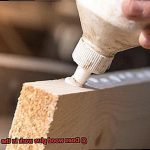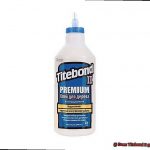Picture this: you’re in your workshop, ready to embark on a woodworking adventure. You’ve got your trusty wood glue in hand, ready to create something magnificent. But wait. Have you ever wondered how frigid temperatures can throw a wrench into your bonding plans? Fear not, my fellow woodworking enthusiasts. Today, we’ll unravel the mysteries of cold weather and its impact on our beloved wood glue. So grab a cup of hot cocoa and let’s dive in.
Different Types of Wood Glue:
Contents
- 0.1 Different Types of Wood Glue:
- 0.2 Cold Weather Limitations:
- 0.3 Tips for Successful Bonding in Cold Conditions:
- 1 What is Wood Glue?
- 2 What Temperature is Ideal for Using Wood Glue?
- 3 How Does Cold Temperature Affect Wood Glue?
- 4 What Happens if the Temperature Goes Below 50°F (10°C)?
- 5 Creating an Environment Suitable for Working with Wood Glue
- 6 Storing Wood Glue Properly
- 7 Pros and Cons of Working with Wood Glue in Cold Temperatures
- 8 Conclusion
Before we brave the frosty frontier, let’s get acquainted with our allies in adhesive excellence. We have aliphatic resin glue (the yellow warrior), polyvinyl acetate (PVA) glue, epoxy resin adhesive (the superhero of strength), and cyanoacrylate (CA) glue (the quick-drying ninja).
Cold Weather Limitations:
Now, here’s where things get chilly. Cold temperatures are notorious for messing with curing and drying times. As a general rule, most wood glues thrive between 55°F (13°C) and 80°F (27°C). Venture beyond these limits, and you might find yourself facing weaker bonds and prolonged drying times.
Aliphatic resin glues can handle colder temperatures better than their counterparts but don’t push it too far. PVA glues and epoxy resins start losing their magic as the mercury drops below their optimal range.
Tips for Successful Bonding in Cold Conditions:
The cold won’t defeat us. Here are some tips to ensure your bonds stay strong even when Jack Frost is nipping at your fingertips:
- Pre-condition Materials: Give your wood and glue a warm-up session by storing them in a temperature-controlled environment before use. This helps them acclimate to the cold, minimizing any potential glue-related mishaps.
- Warm Up the Environment: If your workshop resembles an ice palace, it’s time to break out the big guns. Space heaters or other heating devices can turn your icy lair into a cozy haven for bonding brilliance.
- Follow Glue Manufacturer’s Guidelines: Don’t be a rebel. Stick to the glue manufacturer’s instructions (pun intended) regarding temperature ranges and best practices. Each glue has its own quirks, so make sure you’re playing by their rules.
Use Accelerators
What is Wood Glue?
Wood glue, also known as carpenter’s glue or woodworking adhesive, is a critical component in any woodworking endeavor. Whether you’re a seasoned carpenter or a passionate DIY enthusiast, understanding the intricacies of wood glue and its applications is essential for creating sturdy and long-lasting bonds between wooden pieces.
Wood glue is typically crafted from a blend of natural or synthetic polymers, such as polyvinyl acetate (PVA), urea-formaldehyde, or epoxy. Each variant possesses its own unique characteristics and purposes. Let’s delve deeper into some popular types of wood glue:

- PVA Wood Glue: This is undoubtedly the most widely used variety of wood glue. It boasts a water-based composition that dries transparently and is remarkably user-friendly. PVA glue suits most woodworking tasks, including board joining, edge gluing, and veneering. Moreover, it’s non-toxic and can be effortlessly cleansed with water.
- Urea-Formaldehyde Glue: This adhesive, formulated with resins, offers a stronger bond than PVA glue. It’s commonly employed in high-stress scenarios or when bonding hardwoods. To activate and cure urea-formaldehyde glue, heat and pressure are required.
- Epoxy Glue: Comprising a resin and hardener, epoxy glue is a formidable two-part adhesive. It creates an immensely robust bond and exhibits resistance against moisture, chemicals, and temperature fluctuations. Epoxy is frequently utilized for specialized woodworking projects or when bonding different materials together.
Wood glue can be found in various forms – liquid, gel, or paste. Liquid wood glue reigns supreme as the most prevalent type, effortlessly applicable with brushes or squeeze bottles. Gel wood glue boasts a thicker consistency, rendering it ideal for vertical applications or gap filling. Meanwhile, paste wood glue possesses greater thickness than liquid variants but necessitates additional drying time.
To ensure optimal results when working with wood glue, it is crucial to ensure that the surfaces being bonded are clean, dry, and devoid of any debris or finish. The application of pressure during the drying process aids in establishing a strong bond, and clamps or weights can be employed to maintain the pieces together until the glue cures.
What Temperature is Ideal for Using Wood Glue?
Achieving a strong and reliable bond when using wood glue is highly dependent on temperature. So, what temperature is ideal for using wood glue? Let’s delve into the details.
The optimal temperature range for using wood glue typically falls between 50°F (10°C) and 80°F (27°C). Within this range, the glue can cure properly and create a bond that will stand the test of time. But why is temperature so crucial in this process?
When temperatures are too cold, below 50°F (10°C), the glue may struggle to cure properly. Cold temperatures slow down the drying process, making it difficult for the glue to harden and create a strong bond. In such cases, it is advisable to warm up both the glue and the wood surfaces slightly before application. This can be done by keeping the glue bottle in a warm room or using a heat gun or hairdryer to gently warm up the wood surfaces.
Conversely, if temperatures are too hot, above 80°F (27°C), the glue may cure too quickly. When this happens, the glue does not have enough time to penetrate and bond with the wood fibers effectively, resulting in a weaker bond. To counteract this issue, it is best to cool down both the glue and the wood surfaces before application. Storing the glue in a cool place or using a fan or air conditioner to lower the ambient temperature can achieve this.
It is important to note that different types of wood glues may have specific temperature requirements for optimal performance. For example, waterproof or exterior-grade wood glues may have a wider temperature range and can withstand colder or hotter temperatures.
Before using wood glue, always check the manufacturer’s instructions or product label for specific temperature guidelines. Different brands and types of wood glues may have slightly different recommendations.
In addition to temperature considerations, it is also worth taking into account environmental conditions when using wood glue. Humidity levels can affect the curing process, so it is best to work in a well-ventilated area with moderate humidity levels.
In extreme temperature conditions, such as very cold or very hot environments, it is advisable to avoid using wood glue altogether. Extreme temperatures can significantly impact the adhesive properties and compromise the strength of the bond.
How Does Cold Temperature Affect Wood Glue?
In the world of woodworking, a strong bond is the foundation for creating enduring and exquisite creations. Wood glue is a trusted adhesive that facilitates the joining of wood pieces, but its effectiveness can be compromised by cold temperatures. In this article, we will explore the intricate relationship between wood glue and cold temperatures, unveiling the intriguing ways in which they interact.
Curing Conundrum:
Wood glue relies on specific temperature ranges to cure effectively. When exposed to cold temperatures, the glue may take longer to dry or fail to dry altogether. Consequently, weak or incomplete bonds can form between the wood surfaces being joined.
Viscosity versus Versatility:
Cold temperatures cause wood glue to thicken and become more viscous. This increased viscosity hinders even spreading on wood surfaces, resulting in uneven coverage and weaker bonds. Therefore, it is crucial to monitor the flow resistance of the glue when working in cold conditions.
Frozen Fiasco:
Certain wood glues contain water as a solvent, and freezing temperatures can spell disaster. The expansion of frozen water can cause the glue to lose its adhesive properties, crack, or become brittle. As a result, the strength and durability of the bond are compromised – an unacceptable outcome for any woodworking masterpiece.
Chemical Slowdown:
Wood glue relies on chemical reactions to harden and create robust bonds between surfaces. Unfortunately, cold temperatures can slow down or halt these reactions altogether. Consequently, the glue may not fully cure, leading to weakened bonds that are unable to withstand the test of time.
Tips for Optimal Bonding:
- Consult the manufacturer’s instructions for recommended temperature ranges during application and curing.
- Warm up both the wood and the surrounding environment before applying the glue. By bringing the wood indoors or utilizing heating devices, you can create a favorable environment that promotes proper glue curing.
What Happens if the Temperature Goes Below 50°F (10°C)?
In this blog post, we will explore the intriguing relationship between wood glue and cold temperatures, uncovering the potential consequences and offering tips to navigate this treacherous terrain.
Curing Conundrum:
Wood glue relies on a chemical reaction to cure and create strong bonds. However, when exposed to cold temperatures, this process can slow down or even come to a halt. The result? Bonds that may not fully set or reach their intended strength. So, be mindful of the temperature when using wood glue and ensure it’s within the recommended range for optimal curing.
Brittle Bonds:
As the temperature drops, wood glue becomes more rigid and prone to cracking or breaking under stress. Imagine your carefully crafted joints weakened by brittle connections that can’t withstand the test of time. To avoid this icy adversity, consider warming up both the wood surfaces and the glue before application to improve flexibility and enhance bond strength.
Frozen Fiasco:
Some wood glues contain water as a solvent, making them vulnerable to freezing temperatures. When water molecules freeze within the adhesive, they can disrupt its structure and weaken its bonding capabilities. To prevent this frozen fiasco, store wood glue in temperature-controlled environments or opt for specialized glues formulated for colder conditions.
Chemical Slowdown:
Wood glue relies on chemical reactions to solidify and create durable bonds. However, in cold weather, these reactions slow down or stop altogether, impeding the curing process. This can result in weaker bonds that may not hold up under pressure. So, be patient and allow sufficient time for the glue to cure properly before subjecting your project to stress.
Conclusion:
Wood glue and cold temperatures don’t always make for a harmonious union. From compromised curing to brittle bonds and frozen fiascos, it’s essential to understand the potential consequences of using wood glue below 50°F (10°C). By following manufacturer guidelines, warming surfaces, and choosing specialized glues, you can ensure optimal bonding even in chilly conditions. So, brace yourself for the chill factor and let your woodworking masterpieces defy the cold.
Research:
In this section, we will explore the potential consequences of subjecting wood glue to temperatures below 50°F (10°C). It is important to understand that wood glue, like any adhesive, has specific temperature limits within which it can effectively bond materials together. When exposed to extreme cold temperatures, the properties of wood glue can be negatively affected.
One of the primary issues with using wood glue in temperatures below 50°F (10°C) is its ability to cure properly. Wood glue typically relies on a chemical reaction to harden and create a strong bond between two surfaces. However, cold temperatures can slow down or even halt this curing process. As a result, the adhesive may not fully set or reach its intended strength.
Another concern when using wood glue in cold temperatures is the potential for the adhesive to become brittle. As the temperature drops, the glue’s flexibility decreases, causing it to become more rigid and prone to cracking or breaking under stress. This can significantly weaken the bond and compromise the overall durability of the glued joint.
Furthermore, moisture content in wood glue can also be affected by low temperatures. When exposed to cold conditions, water molecules within the glue may freeze, leading to ice crystals formation. These ice crystals can disrupt the adhesive’s structure and weaken its bonding capabilities. Additionally, if the glue freezes and thaws repeatedly, it can undergo physical changes that further compromise its effectiveness.
Creating an Environment Suitable for Working with Wood Glue
Wood glue is a versatile adhesive that can bond wood pieces together, creating sturdy and long-lasting connections. However, to achieve optimal results, it is essential to create a suitable workspace that takes into account the temperature conditions.
In this blog post, we will explore the importance of creating an environment conducive to working with wood glue, with a specific focus on cold temperatures. So, grab a cup of hot cocoa and let’s dive in.
Understanding the Impact of Temperature:
Temperature plays a critical role in the effectiveness of wood glue. Cold temperatures can significantly affect the curing process, leading to weaker bonds and longer curing times. On the other hand, if the temperature exceeds the recommended range, the glue may cure too quickly, compromising bond strength.
Tips for Creating an Ideal Workspace:
- Temperature Control: To ensure optimal bonding, maintain a consistent temperature within the recommended range (around 70°F or 21°C). Use a thermometer to monitor the temperature and adjust heating as needed. Avoid working in extreme cold or hot conditions that can hinder the glue’s performance.
- Climate Considerations: Adapt your workspace based on your location’s climate. In colder climates, additional heating may be necessary to maintain a suitable temperature for wood glue application. In hotter climates, proper ventilation or air conditioning is vital to prevent excessive heat that can compromise bond strength.
- Pre-conditioning Materials: If your wood or other materials have been stored in a cold environment, bring them into a warmer space and allow them to acclimate before applying wood glue. This prevents temperature differentials that could negatively impact bonding. Imagine taking a block of icy wood and applying warm glue – it’s like mixing fire and ice.
- Draft-Free Zone: Choose a well-ventilated workspace while avoiding drafts that can disrupt the curing process. Close windows and doors if necessary to minimize airflow and maintain optimal conditions. Imagine a gentle breeze blowing through your workspace, carrying away the adhesive properties of the glue – not ideal.
- Consider Alternative Adhesives: In extreme temperature conditions where wood glue may not perform optimally, explore specialized adhesives designed for colder or hotter environments to ensure strong bonds. These alternative adhesives are like superheroes that can withstand extreme temperatures and still provide excellent bonding power.
Storing Wood Glue Properly
In this comprehensive guide, we’ll delve into the best practices for storing wood glue to maintain its effectiveness. So, grab your tools, and let’s dive in.
The Impact of Temperature:
Temperature is a key player in preserving the longevity and strength of wood glue. Extreme temperatures can wreak havoc on its bonding capabilities, so it’s crucial to store it in a cool, dry sanctuary. Here’s what you need to know:
- The Sweet Spot: Aim for a storage temperature between 55°F (13°C) and 75°F (24°C). This magical range ensures that the glue stays stable, avoiding freezing or overheating.
- No Freezing Allowed: Jack Frost is no friend to wood glue. Freezing temperatures cause the water content in the glue to expand, damaging its adhesive properties. Steer clear of storing it in freezing zones like unheated garages or chilly sheds.
- Hot Glue? Not Cool: Excessive heat is another enemy of wood glue. It dries out rapidly or even solidifies in the bottle, making it a nightmare to apply and compromising its bonding abilities. Keep your glue away from scorching sunlight and heat sources like radiators or heaters.
Workspace Tips for Glue Storage:
Now that we’ve tackled temperature, let’s dive into some hands-on tips for storing your wood glue:

- Seal It Tight: Think of your wood glue as a secret treasure—keep it tightly sealed when not in use. This prevents air exposure and maintains its viscosity and adhesive prowess.
- Avoid Moisture: Moisture is like kryptonite to wood glue’s superhero strength. Ensure your storage area is dry as a desert. Consider airtight containers or cabinets for an extra layer of protection against humidity.
- Follow Manufacturer’s Instructions: Don’t be a rebel—heed the manufacturer’s storage instructions. Different wood glues may have specific guidelines for optimal storage conditions. Ignoring them could jeopardize your glue’s effectiveness.
Testing Your Glue:
If you suspect your wood glue has endured extreme temperatures or improper storage, play it safe with a bonding strength test before embarking on important projects. Simply apply a small amount of glue to scrap wood and inspect its secure bond.
Pros and Cons of Working with Wood Glue in Cold Temperatures
Wood glue is a vital component in woodworking projects, providing the necessary bond to hold everything together. However, when faced with cold temperatures, using wood glue can present unique challenges. This article will explore the advantages and disadvantages of working with wood glue in cold temperatures, enabling you to make informed decisions for your chilly woodworking projects.
The Pros:
- Extended Working Time: Cold temperatures slow down the curing process of wood glue, giving you ample time to fine-tune your project. Take advantage of the extra time to align joints precisely and make adjustments without worrying about premature bonding.
- Stronger Bond: Surprisingly, wood glue can form a stronger bond in colder temperatures. The slower curing process allows the glue to penetrate deeper into the wood fibers, resulting in a more durable connection over time. This is particularly beneficial for projects that require enhanced strength.
The Cons:
- Longer Curing Time: The benefits of using wood glue in cold temperatures come with some drawbacks. The lower temperatures mean that your wood glue will take longer to fully cure and reach its maximum strength. If you are working on a tight deadline, this prolonged curing time may cause frustration.
- Reduced Initial Tackiness: In colder weather, wood glue may lose some of its initial tackiness. This can make it more challenging to hold pieces together during assembly as slippage and movement become more likely. To ensure a secure bond until the glue sets, be prepared to use additional clamps or alternative methods.
- Beware of Frost Damage: Extreme cold can be detrimental to wood glue. Exposure to freezing conditions can crystallize or render the adhesive ineffective. To prevent potential failure or weakening over time, store your glue appropriately and keep it away from freezing temperatures.
CgoTvLdJOaY” >
Also Read: How to Make Glue Dry Faster
Conclusion
When it comes to wood glue, temperature matters. You might be wondering, how cold is too cold for wood glue? Well, here’s the deal – extreme cold can wreak havoc on the adhesive properties of wood glue. If the temperature drops below freezing, you’re in trouble. The glue becomes brittle and loses its ability to bond effectively. It’s like trying to stick two ice cubes together – it just won’t hold.
But wait, there’s more. Even if it’s not freezing outside, you still need to be cautious. Cold temperatures slow down the curing process of wood glue. This means that it takes longer for the glue to dry and reach its maximum strength. So, if you’re working in chilly conditions, you’ll have to exercise patience and give the glue ample time to set properly.
Now, let’s talk numbers. Generally speaking, most wood glues start losing their effectiveness below 40 degrees Fahrenheit (4 degrees Celsius). At this point, you’ll notice a significant decrease in bonding strength. And as the temperature continues to drop, so does the reliability of your glue.
So what’s the takeaway here? To ensure a strong and lasting bond, avoid using wood glue in extremely cold conditions or when temperatures are approaching freezing point. Instead, opt for a climate-controlled environment where both you and your trusty wood glue can thrive.






